Lessons from a lonely tortoise
In the Galapagos Islands, scientists are struggling to save some of the most endangered creatures in the world.
By Bryn Nelson
PUERTO AYORA, ECUADOR — At first glance, the world’s rarest creature looked just like a big boulder.
I had scanned a large, plant-filled enclosure several times before locating him: a 70-something-year-old tortoise named Lonesome George. The tortoise weighs 88 kilograms (nearly 200 pounds), but he was barely visible beyond several bushes, and his head and legs were tucked neatly within his shell.
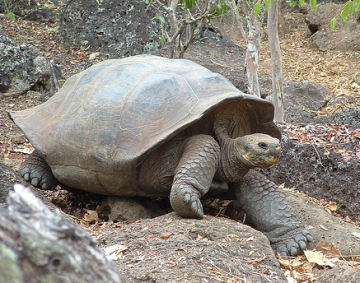 |
|
An adult Galápagos tortoise lumbers within a semiprotected space at a breeding facility on San Cristobal Island.
|
| Bryn Nelson |
Like a stubborn child who refuses to leave his room, George is not the most sociable tortoise in the world. But he’s by far the most famous, and I was happy to spot him—or at least his shell. That’s because George is the last known member of his species, sometimes called the Pinta tortoise.
A special place
George lives in the Galápagos Islands, a group of 19 islands in the Pacific Ocean about 600 miles (a little less than 1,000 km) west of Ecuador. The islands are famous for their unique plants and animals. For example, many of the islands’ lizards, iguanas, tortoises, sea lions, seabirds, land birds called finches, and even a type of penguin, have been found nowhere else in the world.
Recent reports, however, suggest that many species in the Galápagos are in trouble. Scientists blame the growing problem on too much tourism, too many people moving to the islands, and the introduction of foreign plants and animals that are crowding out or killing native species.
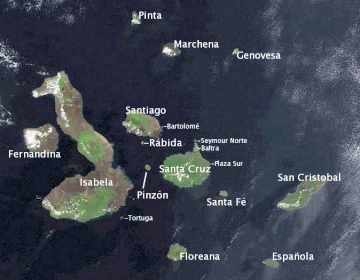 |
|
Based on satellite photographs taken by NASA, this image shows the major islands in the Galápagos.
|
| Wikipedia/NASA |
But researchers and volunteers are working hard to save threatened animals such as the tortoises. Using a range of strategies, from radio collar–wearing goats to analyses of old tortoise bones, they are making a difference—and showing that a shy survivor named George may not be so alone after all.
The rarest creature
Before humans first arrived in the Galápagos Islands in the 1500s, 15 or more closely related tortoise species may have lived there. Twelve of those species still inhabit the islands, but two are extinct. Lonesome George is the last known member of the third.
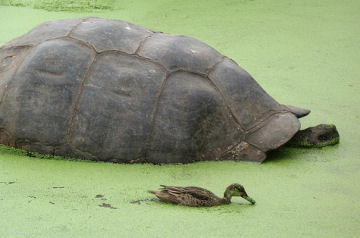 |
|
A Galápagos tortoise shares a morning bath with a white-cheeked pintail in a duckweed-covered pool in Santa Cruz Island’s highlands.
|
| Bryn Nelson |
Scientists found George living alone on an island in the Galápagos called Pinta Island in the early 1970s. Because he is the last remaining Pinta tortoise that scientists know about, the Guinness Book of World Records has called him the “rarest living creature.”
I recently took a weeklong voyage through the Galápagos aboard a motor-powered yacht named the Letty. Aboard the boat, I met wildlife photographer Tui De Roy, who told me that several tortoise species were in even worse shape when she was a girl.
De Roy moved to the Galápagos Islands when she was 2 and lived there for more than 35 years. Now a resident of New Zealand, she helps oversee the Charles Darwin Foundation.
The foundation operates the Charles Darwin Research Station on Santa Cruz Island in the Galápagos. Scientists at the station advise the Ecuadorian government on how best to protect the Galápagos Islands.
By some estimates, De Roy says, up to 500,000 tortoises were killed for food or taken away as pets in the centuries before concerned people began protecting them. By the time preservation efforts began, perhaps only one-tenth of the original population remained.
Laws now protect the tortoises from hunting, but the lure of money still drives some people to kill the tortoises and sell their meat. Galápagos tortoises also face new dangers from animals that didn’t originally live on the islands, including goats.
Pesky goats
Over the past few centuries, fishers, pirates, sailors, and settlers brought goats to the Galápagos as a reliable food source. Unfortunately for tortoises, goats like the same types of grasses, fruits and leaves as tortoises do, and the goats are faster movers.
As the goats multiply, they beat tortoises to prime grazing spots. And they trample other favorite tortoise foods, like young prickly pear cacti.
As they stomp around, the hoofed animals can also squash sandy areas near the shoreline where tortoises build their nests. Over time, huge herds of goats can turn leafy forests into barren grassland.
 |
|
This mural on the island of San Cristobal reads, “These introduced vertebrate animals are a menace in the Galápagos.” Pictured are a rat, cat, dog, pig, and goat—among the most destructive newcomers in the Galápagos Islands.
|
| Bryn Nelson |
Researchers have used helicopters, dogs, and even other goats to track down the goat invaders. The tracker goats wear radio collars that allow scientists and hunters to follow them as they mingle with wild goats. The researchers also put bright paint on the tracker goats, so hunters know to leave them alone but to nab their wild companions.
Goats be gone
The antigoat campaign has been paying off. Last year, researchers removed the last of an estimated 75,000 to 125,000 wild goats from the northern part of Isabela Island, which boasts more tortoise species than any other island in the Galápagos.
The victory built upon earlier successes on several other islands. On an island named Española, thousands of goats were removed in the 1970s, De Roy says. By then, the island’s native tortoise population had dwindled to 12 adult females and 2 males.
In the 1960s and early 1970s, researchers evacuated those few surviving tortoises to the Charles Darwin Research Station some 60 miles away. There, they set up an emergency-breeding program.
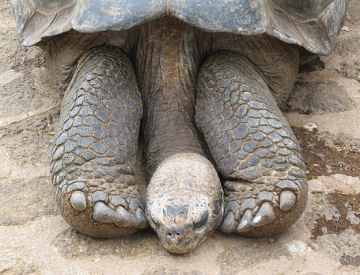 |
|
This male tortoise was once kept illegally as a pet. Now, he stretches out at the Charles Darwin Research Station on Santa Cruz Island.
|
| Bryn Nelson |
A third male tortoise from Española, named Macho, was already living at the San Diego Zoo. Scientists later brought him to the research station to help restore the island population. The descendants of Española have now helped resettle more than 1,400 tortoises on their goatfree native soil.
“Española is one of the most beautiful stories” of tortoise success, says Gisella Caccone, an evolutionary biologist at Yale University.
A stunning find
Earlier this year, Caccone and her colleagues announced another stunning discovery: Lonesome George may not be alone after all.
The discovery began with a routine study of the genetic material known as DNA. Every animal’s DNA is different, but researchers can look for common patterns among members of the same species that distinguish them from other species. A crow’s DNA, for example, looks significantly different from a hawk’s DNA, even though both creatures are birds.
First, Caccone’s team extracted a sample of DNA from George’s blood. The researchers also took DNA from the bones of long-dead Pinta tortoises that had been stashed away in museums for decades. By looking at samples of both living and dead specimens, the scientists came up with a profile of a typical Pinta’s DNA.
Next, the team compared the Pinta DNA with DNA from tortoises living on neighboring Isabela Island. They already knew the Isabela population had a mixed heritage, and they wanted to know more about where the ancestors of the Isabela tortoises had come from.
Their results surprised them. One young Isabela male tortoise, the scientists learned, shared half of George’s DNA. Caccone says that this discovery suggests that the youngster’s mom was likely born on Isabela Island. But his dad, like George, originally lived on Pinta Island, about 50 miles away.
No one knows how the tortoise father made the trip to Isabela. It’s possible that he and others rode to their new home with sailors or settlers, or on strong ocean currents. Unlike sea turtles, tortoises live only on land. Even so, tortoises have been known to survive for long periods in the ocean, whether floating by themselves or clinging to mats of vegetation. Some researchers, in fact, believe the first tortoises to arrive in the Galápagos Islands did so by floating westward from the mainland.
Either way, the new find has researchers hoping they’ll be able to identify more Pinta tortoises now living on Isabela—or at least tortoises that are partly descended from Lonesome George’s extended family. If they can find both males and females with Pinta DNA, scientists will start a new breeding program to pass on as much of that unique DNA to tortoise hatchlings as possible. If they’re really lucky, their breeding program may help the Pinta species survive. George, who seems completely uninterested in reproducing, would be off the hook.
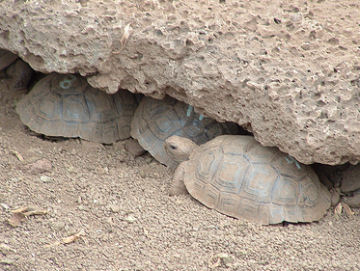 |
|
These tortoise hatchlings are a few years old. Here, they seek shelter from the heat at the Charles Darwin Research Station on Santa Cruz Island in the Galápagos. Researchers have bred these hatchlings in captivity and will release them into the wild once they reach their fifth birthday.
|
| Bryn Nelson |
Caccone’s group has done more than revive the hope of rescuing Pinta Island tortoises from the brink of extinction. Two years ago, the team also discovered a previously unknown species of tortoise on Santa Cruz Island, where most people in the Galápagos Islands live. The isolated population of about 100 tortoises still doesn’t have a formal name.
“The Galápagos can yield an incredible amount of new surprises,” Caccone says. “Think what you can find when you really study well the other islands.”
Going Deeper:







